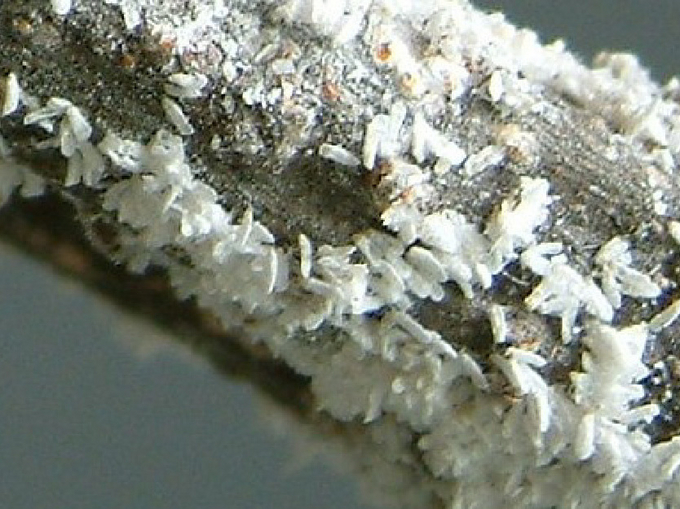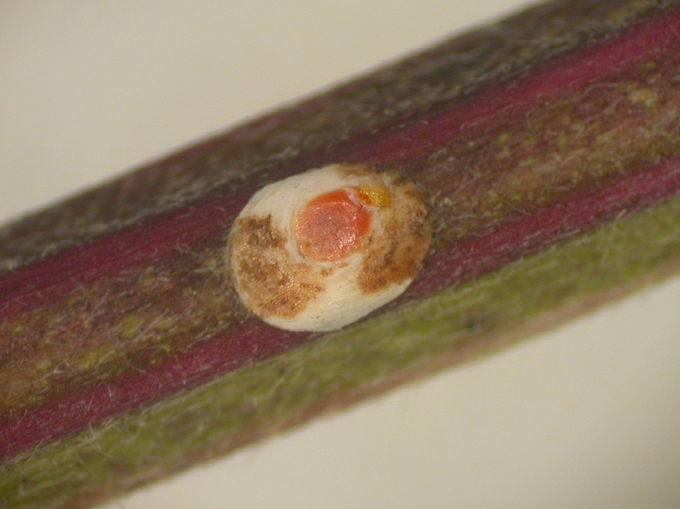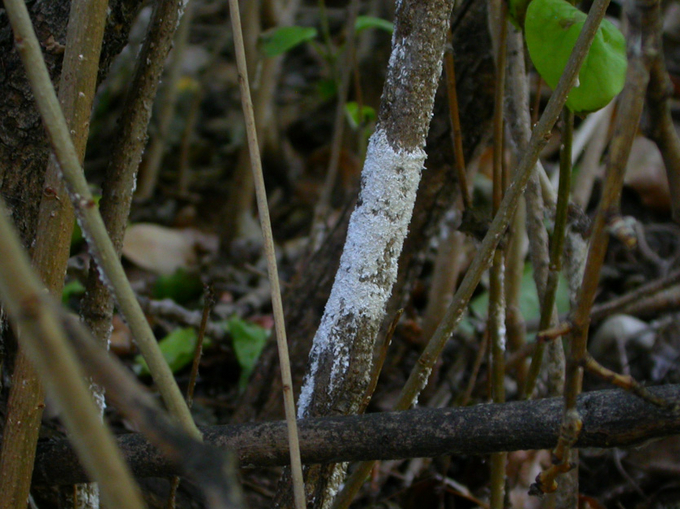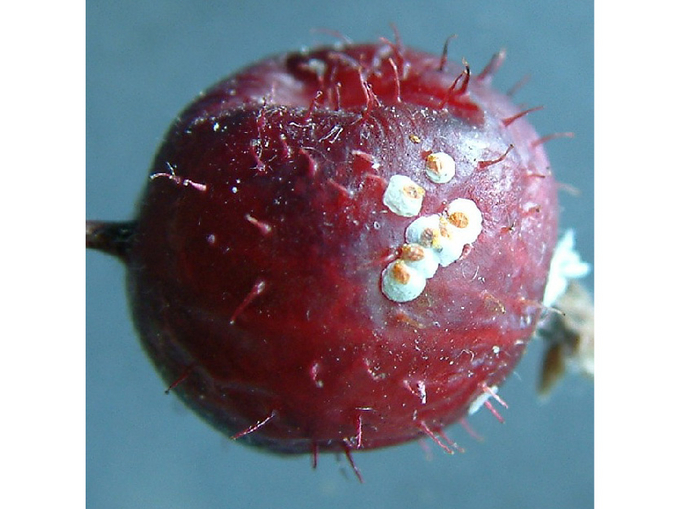Mulberry scale
Pseudaulacaspis pentagona
Appearance
Characteristic is the back shield of the adult animals, which contributes to the naming.
Both in the juvenile stages as well as in the adult animals a pronounced sexual dimorphism (=clear differences between the appearance of the sexes) is shown:
Males: they live only a short time as adults, but here they also form winged forms (wingspan up to 1.5 mm) and are attracted to mating by sex attractants of the females. Before that, the young males, which usually hatch from white eggs, are distinguished by a conspicuous white colored longitudinal oval shield. This is usually easily recognizable, mainly because the animals stay in masses on the infested plant parts. After hatching, the empty shields of the males remain behind.
Females: They usually hatch from orange eggs and are less conspicuous, because the blister-shaped animals under their roundish-oval shield (white-beige with yellow-brown center) are little distinguishable from the bark of their host plants. With their protective shield, the animals reach a size of about 2 to 3 mm.


Biology
The mulberry scale aphid belongs to the family of cover scale aphids (Diaspididae).
The hibernation of the mulberry scale aphid takes place as a fertilized female which is attached to the wood and can survive very low temperatures (e.g. -18 °C). From May onwards, the female lays about 100 - 150 eggs under the scale, the orange eggs being laid before the white eggs. The larvae hatch after only a few days, but like all developmental steps, it is temperature-dependent. The development takes place above a temperature threshold of approx. 10 °C. The 0.2 mm long larvae ("crawlers") are, like the eggs before, sensitive to temperature setbacks in spring. They pass through different numbers of larval stages (depending on sex), with males barely moving away from the maternal shield during this period. In contrast, the female larval stages are very mobile in the first hours after hatching and actively seek out new infestation sites on the plant, where they attach themselves. This phase of the so-called larval run takes place in our latitudes around the first half of June. From about the beginning of July, the first generation becomes sexually mature.
In the optimal temperature range, at about 25 °C to 30 °C, the mulberry scale aphid needs less than two months for the development of a generation. After mating and egg-laying, the larvae of the second generation develop, so that the mating flight begins again around late summer/fall. In this country, the mated females subsequently overwinter, while in other areas further generations can be formed or, under cooler climatic conditions, only one generation can develop.
Damage symptoms
In the case of mass occurrence of the mulberry scale insect, the infested parts of the plant (often the base of the trunk or leading branches) look as if they have been dyed white or whitewashed. The scale remains even after the animals die. Several layers of the scales can also form on top of each other, which can lead to crust-like structures on the plants. Sometimes the bark also breaks open and parts of the plant or the entire plant dies.
Damage to fruit has also been documented, for example on peaches in Germany. In massive infestations, fruit deformations occurred there. A red halo formed around the sucking spots, and white shields of the males were usually found inside the spots.


Host plants
The mulberry scale aphid is very polyphagous and can feed on well over a hundred host plants from many different plant families. It is considered an important pest of rose plants (Rosaceae), but also occurs on various fruit crops, ornamental and wild plants of other families.
Of the native fruit crops, various soft fruit crops such as currants(Ribes spp.), raspberries and blackberries(Rubus spp.), various stone fruit crops such as peach, apricot, cherry et al.a. (div. Prunus spp.) as well as mulberry (Morus spp.), kiwi(Actinidia sp.), pear (Pyrus sp.), walnut(Juglans sp.), grapevine(Vitis sp.) and others. The following is a selection from the many other potential host plants, from ornamental and wild plants: Maple(Acer sp.), mountain ash (Sorbus sp.), oak (Quercus sp.), ash(Fraxinus sp.), lilac (Syringae sp.), hazel (Corylus sp.), weeping birch (Betula sp.), dogwood (Cornus sp.), hedge myrtle (Lonicera sp.), cherry laurel (Prunus sp.), linden(Tilia sp.),mahonia (Mahonia sp.), oleander (Nerium sp.), pipe bush (Philadelphus sp.),robinia (Robinia sp.), cordwood (Styphnolobium sp.), spindle bush (Euonymus sp.), trumpet tree (Catalpa sp.), willow (Salix sp.), ornamental apple (Malus sp.), dwarf loquat (Cotoneaster sp.).
Distribution
Originating from eastern Asia, the species is now found on all continents and in diverse climatic zones (tropical, subtropical, temperate). Meanwhile it has been found in most countries of Southern and Central Europe. In Austria, it was found to be the most common species during shield aphid surveys in various parks in Vienna in 2008.
Economic importance
The mulberry scale aphid is a difficult pest to control on peach, nectarine, apricot, citrus, almond, currant and kiwi, especially in southern Europe. Internationally, for example in Turkey or in the south of the USA, it is considered one of the most important animal pests of peach.
Prevention and control
- Use of traps for population monitoring (to detect the flight of males).
- Infestation monitoring at harvest based on fruit damage (for peach)
- Mechanical removal of scale insects:
- Brushing off (by hand) / careful blasting with the aid of a high-pressure cleaner (e.g. in older peach plants; after leaf fall in autumn until before budbreak in spring, but not during frost)
- Grubbing up or pruning back heavily infested plant parts (during dormancy, before budbreak) - Destroy material without causing damage (possible state regulations must be observed!)
- Protection/support of natural enemies (chalcid wasps and predators; if necessary, leave cut material in the plant until they overwinter)
- Plant protection products for the control of scale insects are listed in the register of plant protection products approved in Austria.
Last updated: 27.11.2025
automatically translated